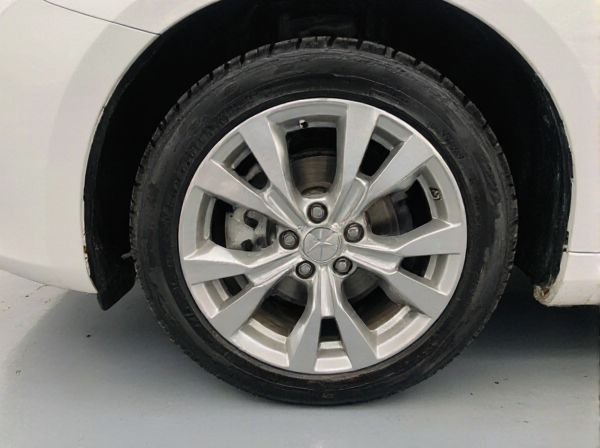
Photo illustration: Split Rim vs One-piece Wheel
Split rims consist of multiple components bolted together, offering easier repairs and customization compared to one-piece wheels. One-piece wheels provide greater strength and structural integrity, making them ideal for heavy-duty applications where durability is crucial. Your choice depends on whether you prioritize maintenance convenience or maximum robustness for your vehicle.
Table of Comparison
| Feature | Split Rim | One-piece Wheel |
|---|---|---|
| Design | Two or three-part assembly, allows rim separation | Single solid piece, no separable parts |
| Maintenance | Easier tire replacement and repair | Requires specialized tools or full wheel replacement |
| Durability | More prone to leaks and air loss | Better airtight seal, longer lifespan |
| Safety | Risk of rim separation if not assembled correctly | Lower risk of mechanical failure |
| Weight | Typically heavier due to multiple components | Lighter, improves fuel efficiency |
| Cost | Generally less expensive upfront | Higher initial cost but less maintenance |
| Use Case | Common in heavy trucks, off-road vehicles | Widely used in passenger cars, performance vehicles |
Introduction to Wheel Construction Types
Split rim wheels consist of multiple components fastened together, allowing easier tire installation and repair, commonly used in heavy-duty and commercial vehicles. One-piece wheels are manufactured as a single solid unit, offering enhanced structural integrity and durability, preferred in passenger cars and performance vehicles. Understanding these wheel construction types helps in selecting the appropriate wheel based on vehicle application, load capacity, and maintenance preferences.
What Are Split Rims?
Split rims consist of two or more detachable pieces that clamp together around the tire, allowing easier tire mounting and dismounting on heavy-duty vehicles like trucks and buses. Their modular design enables maintenance, repair, or replacement of damaged sections without removing the entire wheel. This construction contrasts with one-piece wheels, which are a single, solid unit typically used on lighter vehicles for enhanced structural integrity and simplicity.
Understanding One-piece Wheels
One-piece wheels are constructed from a single solid piece of metal, providing enhanced strength and durability compared to split rims. Their seamless design reduces the risk of air leaks and structural failures, making them ideal for high-performance and heavy-duty applications. Maintenance is simpler with one-piece wheels since there are no bolts or joints that require periodic inspection or tightening.
Key Differences: Split Rim vs One-piece Wheel
Split rims consist of multiple components, typically a separate outer rim and inner rim, allowing easier tire changes and repairs, especially for heavy-duty vehicles. One-piece wheels are cast or forged from a single metal piece, providing higher structural integrity and strength but making tire maintenance more complex. The choice between split rim and one-piece wheel depends on factors like vehicle type, maintenance convenience, and load-bearing requirements.
Safety Considerations for Each Wheel Type
Split rim wheels, commonly used in heavy-duty vehicles, pose higher safety risks due to the potential for sudden air release during tire maintenance, necessitating specialized tools and trained personnel to prevent accidents. One-piece wheels offer enhanced safety by integrating the rim and wheel into a single unit, reducing the likelihood of component separation and simplifying tire installation procedures. Proper inspection and maintenance protocols are critical for both wheel types to ensure durability and minimize the risk of failure during operation.
Performance Impacts: Handling and Durability
Split rim wheels offer easier tire changes and customization but may compromise handling precision due to potential flex at the joint compared to one-piece wheels. One-piece wheels provide superior structural integrity and enhanced durability, resulting in better steering response and consistent performance under high stress conditions. For high-performance applications, one-piece wheels are preferred for their impact resistance and reliable handling characteristics.
Maintenance and Repair: Pros and Cons
Split rims offer easier maintenance since individual components can be replaced without removing the entire wheel, reducing downtime and repair costs. However, they require frequent inspection to avoid safety risks due to loose or damaged segments. One-piece wheels provide greater structural integrity and lower maintenance frequency, but repairs are often more complex and costly, requiring full wheel replacement in case of damage.
Cost Comparison: Initial and Long-term Expenses
Split rim wheels typically have a lower initial cost compared to one-piece wheels, making them attractive for budget-conscious buyers; however, their maintenance and repair expenses tend to be higher over time due to the complexity of assembly and potential for seal failures. One-piece wheels usually require a larger upfront investment but offer lower long-term expenses because of their robust construction and minimal maintenance needs. Evaluating total cost of ownership reveals that one-piece wheels often prove more economical in heavy-duty or long-term applications despite the higher initial price.
Common Applications and Industry Usage
Split rim wheels are commonly used in heavy machinery, agricultural equipment, and commercial trucks due to their ease of tire replacement and ability to handle high loads. One-piece wheels dominate passenger vehicles and racing cars, offering enhanced structural integrity and reduced maintenance requirements. Industrial sectors such as construction, mining, and logistics often prefer split rim wheels for their durability and flexibility in demanding environments.
Which Wheel Type is Right for You?
Split rim wheels offer easier tire changes and repairs due to their two-piece design, making them ideal for heavy-duty and off-road vehicles where downtime must be minimized. One-piece wheels provide enhanced strength and durability with a seamless construction, suitable for regular passenger cars and performance vehicles requiring consistent road handling. Choosing the right wheel type depends on your vehicle's usage, maintenance preferences, and load requirements.
 caratoz.com
caratoz.com